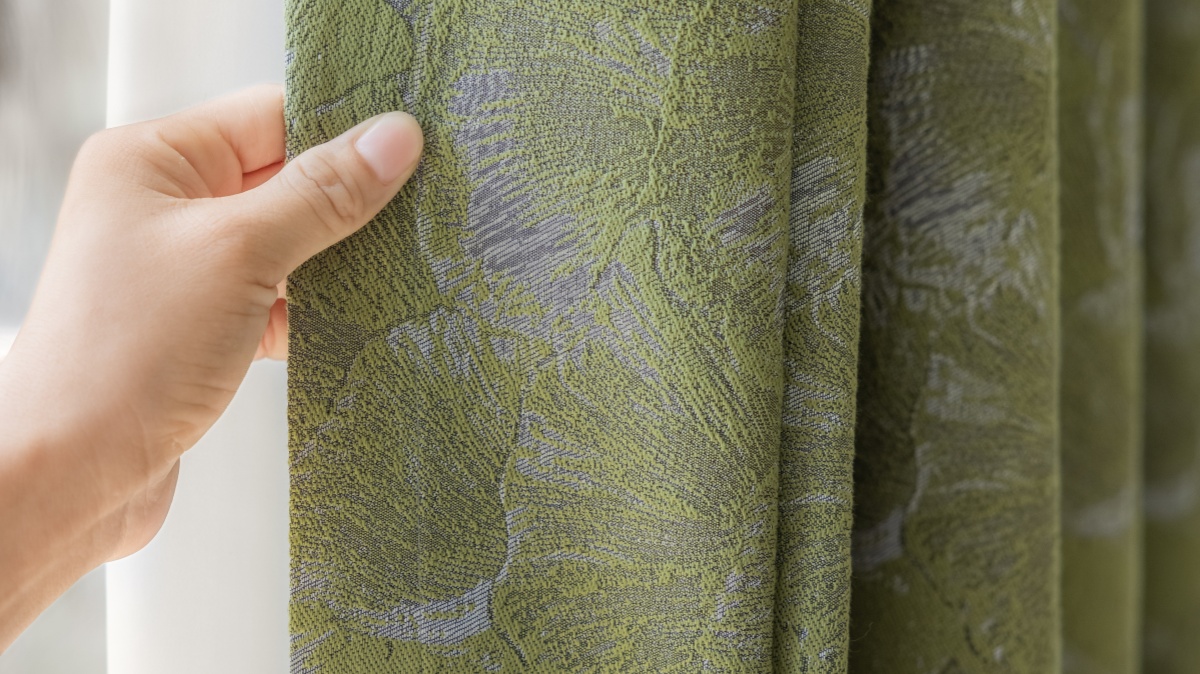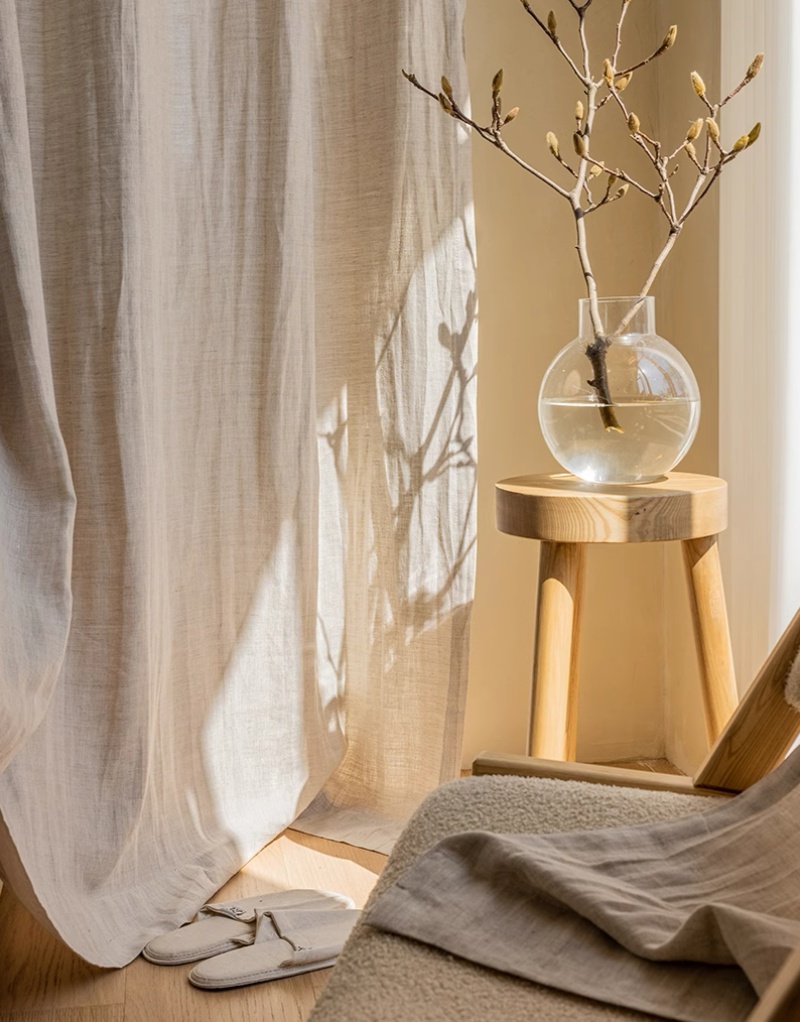
When it comes to dressing up your windows, the material of the curtains holds as much weight as the design and style. Curtains are not just part of the decor; they contribute to the comfort and functionality of a room. Although there are many fabrics to choose from, linen and cotton remain popular choices. How does one decide the best choice for their house? This blog seeks to unravel the main disparities between linen and cotton window coverings so that you can make an intelligent decision.
A Quick Comparison Sheet
|
Feature |
Linen Curtains |
Cotton Curtains |
|
Texture & Drape |
Natural, irregular; crisp yet graceful |
Smooth, even; versatile |
|
Durability |
Strong fibers, improve when wet; withstand sun |
Sturdy, may wear under prolonged sun |
|
Maintenance |
Gentle wash, air dry; wrinkle-prone |
Machine wash, tumble dry; less ironing |
|
Insulation & Light |
Loose weave; breathable, temperature-regulating |
Tighter weave; less breathable, some insulation |
|
Eco-Friendliness |
Eco-friendly flax; biodegradable, recyclable |
Conventional cotton- negative impact Organic- eco-friendly |
|
Cost |
More expensive; luxury item |
More affordable; wide price range |
|
Aesthetics & Styling |
Natural, rustic; less pattern variety |
Smooth, versatile; wide color and pattern range |
Linen Curtains and Cotton Curtains
Before learning further about their differences, it's better to know some basics about these two materials.
-
What's Linen Fabric?
Linen, made from the fibers of the flax plant, clearly has a history running into thousands of years. Well known for its natural sheen and airy appeal, linen fabric infuses elegance and a state of relaxed poise. This fabric is greatly admired for its inherent strength. Because of these characteristics, it has always been a very.
-
Knowing Cotton Fabric
Versatile and highly accepted with wide arms, cotton is a soft, fluffy staple fiber that grows in a boll around the seeds of cotton plants. It has a democratic appeal, thus finding its way into a range of styles-from the most casual to the most formal-owing to its adaptability. Cotton curtains provide a canvas of great possibilities in textiles, color, and design.
Texture and Drape
The tactile experience of a curtain contributes significantly to the atmosphere of a room. Linen exudes a crisp yet graceful drape that whispers casual elegance and timeless charm. Its natural, slightly irregular texture offers an organic, lived-in feel that becomes softer with each wash. Cotton is the smoother operator of the two. Its texture is even and consistent, offering a versatility that can swing from breezy lightness to a more substantial presence depending on the weave.
Durability and Longevity
Linen is the heavyweight champion in the ring of durability. Why? Well, imagine a fabric that flexes its muscles even more when you splash it with water. That's linen for you – It's renowned for its strong fibers, which actually become stronger when wet, ensuring that linen curtains can bear the brunt of sun exposure and repeated laundering without losing their integrity. Cotton, on the flip side, is sturdy, sure, but put it under the harsh spotlight of the sun day in and day out, and it'll start to show signs of wear – colors might lose their pep and the fabric could get a bit frail.

Maintenance and Care
For those seeking practicality in home textiles, cotton curtains are a clear winner. They withstand regular machine washing with ease, requiring only a gentle tumble dry at low heat to prevent excessive wrinkling. Even if wrinkles do form, they're usually manageable with minimal ironing. This makes cotton a low-maintenance option for anyone looking to minimize their household chores.
Linen curtains, while beautiful, demand more careful handling. They should be washed gently to maintain the integrity of the fibers and are best dried by hanging them up to air dry, which avoids the high temperatures that could cause them to lose their shape or shrink. Linen is naturally more prone to wrinkling, though it's a part of their charm. But those who prefer a smoother look may find themselves ironing these curtains more frequently.
Insulation and Light Filtering
Thermal insulation and light control are important factors in curtain selection. Linen has a natural, loose weave that allows more light to pass through compared to cotton. This makes linen curtains ideal for rooms where you want a soft, diffused light. For temperature control, linen is highly breathable and has natural temperature-regulating properties.
Cotton curtains, especially those with a tighter weave or thicker fabric, offer better light filtering compared to linen. They can effectively block out more sunlight, making them suitable for bedrooms or media rooms where you need better light control. However, cotton is less breathable than linen but still offers some insulation properties. Thicker cotton curtains can help maintain a room's temperature by reducing heat transfer through windows.
Environmental Impact
Produced from flax plants, which are naturally resilient and require minimal intervention in the form of pesticides, fertilizers, or excessive watering, linen is an eco-friendlier option. The adaptability of flax allows it to thrive even in poor soil, lessening the need for chemical fertilizers that can be detrimental to the environment. Additionally, linen's ability to biodegrade and be recycled contributes to its reputation as a sustainable textile choice, minimizing its long-term impact on the planet.
Conventional cotton production often involves the use of pesticides and fertilizers, which can have a negative environmental impact. However, organic cotton is grown without these harmful chemicals and is a more eco-friendly option. Cotton is a water-intensive crop, requiring significant amounts of water for cultivation. This can strain water resources in regions where cotton is grown. Like linen, cotton is biodegradable and recyclable, making it a sustainable choice when disposed of properly. Many cotton curtains are now made using recycled cotton or a blend of recycled and organic cotton, reducing the environmental impact of production.
Cost
Linen is typically more expensive than cotton due to the labor-intensive process of harvesting and processing flax plants. The limited supply of flax plants compared to cotton also contributes to the higher cost of linen fabric. Linen curtains are often considered a luxury item and are priced accordingly.
Cotton is more widely available and cheaper to produce compared to linen, making cotton curtains more affordable. The abundance of cotton crops and streamlined production processes help keep the cost of cotton curtains lower. Cotton curtains come in a wide range of prices, from budget-friendly options to high-end designer curtains. Even organic cotton curtains, which are more expensive than conventional cotton curtains, are often more affordable than linen curtains.
Aesthetic and Styling Options
Aesthetic preferences drive the final look of your windows. Linen curtains have a natural, irregular texture that creates a rustic, organic, and slightly informal look. Cotton curtains have a smooth, uniform texture that offers a crisp, clean, and versatile appearance, suitable for both formal and informal spaces.
In terms of adaptability and customization, cotton curtains are available in a wider range of colors, patterns, and prints, making them more adaptable to various interior design styles and allowing for greater customization. Linen curtains, while available in different colors, are less varied in terms of patterns and prints, limiting their adaptability compared to cotton curtains.

Unravel the Beauty of Linen and Cotton in Your Home
Selecting curtains between linen and cotton becomes a very personal, practical, and aesthetic decision. Through this comparative analysis, we've unraveled the threads of fact from each fabric, offering insights into their respective strengths and limitations. As you stand before the windows to your world, ponder not only on the view outside but also on the ambiance you wish to cultivate within. Your final act of selection will not merely cover a window but also reveal the character of your home.
